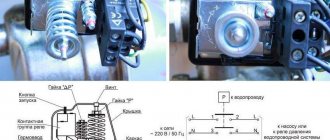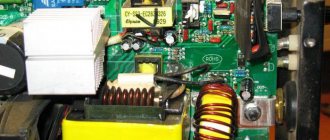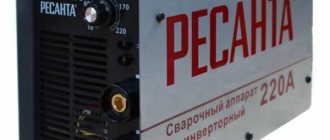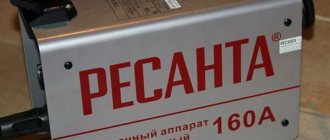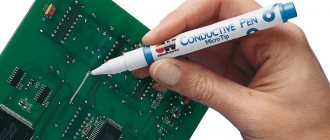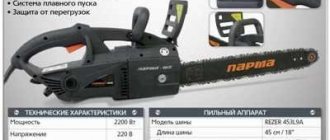Modern welding work is carried out using special inverters. Previously, conventional transformers, which are characterized by lower efficiency, were used for such metal processing. The schematic diagram of a welding inverter may differ slightly, but they are all characterized by lightness and compactness. Only by taking into account the design features can the welding inverter be repaired and fine-tuned.
Device performance characteristics:
Dimensions of the main unit: 445 x 180 x 271 mm
Device weight: 5.3 kg. Place of production: Republic of China
Warranty: 12 months
Tool class: For domestic needs Equipment type: Inverter Welding type: (MMA) (coated electrode welding) Power: 5500 W Welding current of the device: DC constant
Phase options: 1 Power source type: mains (220 V) Electrode diameter range: 1.6 - 5 mm Max. possible power: 5000 W Max. mains voltage: 180-240 V Cooling form: forced air Protection class / insulation type: IP 21/H Min. current: 20 A No-load voltage: 75 V Rated frequency: 50 Hz Packaging type: Plastic suitcase
Inverter 3200 and 4000 circuits
For manual arc welding, you can use the Inverter 4000 or 3200. Both machines have an almost identical design, which provides the following functions:
- Protection against electrode sticking effect.
- Protecting key components from severe voltage surges.
- Control of basic arc parameters.
- Built-in cooling element with control sensors.
During the manufacture of inverters, IP21 protection was provided. The power of the device is 5.3 kW, powered by a standard power supply network. The detailed diagram of inverter 3200 pro determines the very attractive properties of these models, due to which they have become widespread.
Advantages of Gerrard MMA-200
The Gerrard MMA-200 Home Line is a new remake of the MMA-200 variant of the same brand. The modernized version is equipped with an electronic dial and a convenient handle for transportation. The engineers also took care of transporting the device by providing it with a special case. Being light in weight, you can easily use Gerrard MMA-200 during installation at height; it does not hinder your movements. If you are the owner of a car repair shop, or you need a welding machine at your summer cottage or garage, this model is perfect. Gerrard MMA-200 is designed for welding, cutting and surfacing of various ferrous and non-ferrous metals. Having a wide range of possible electrodes used, the welder will be able to choose any required diameter up to 5 mm. This model has the first class of protection against electric shock. The device is very quiet in operation, low energy consumption, and excellent value.
Elements of the electrical circuit of welding inverters
The electrical circuit diagram of an inverter welding machine involves a combination of several elements that are interconnected. The main ones can be called:
- The block responsible for supplying energy to the power section. This element is represented by a combination of several devices that are capable of changing current parameters to the required values. Typically, a capacitive filter and a rectifier are included.
- The device includes a power transformer. The power supply of the welding inverter also includes a 4n90 transistor.
- A separate element is responsible for powering the low-current part of the structure.
- To control the main parameters, a PWM controller is installed. It is represented by a combination of a load current sensor and a transformer.
- A separate block is responsible for protecting the structure from heat. When electrical current passes, some components may become very hot. Therefore, an additional cooling module is installed, represented by a fan and a temperature sensor.
- Control units that allow you to set basic parameters, as well as display elements.
Example of circuit diagram for current 250A
The diode bridge equipment for the welding machine is manufactured and installed taking into account the power of the device and some other points. Each device has its own characteristics, which we will consider in detail below.
gerrard mma 200 reviews
Based on reviews, we have compiled a characteristic of this inverter. Most users, even if they noticed the negative aspects of the product, were generally satisfied with the purchase and did not regret the money spent. In addition, do not forget that among the buyers there are many beginners in the field of welding, who attribute their own operational errors to the inverter. Let's look at the advantages of the device that domestic consumers have noticed:
- good device for little money;
- long-term operation of the device, which is not typical for inverters, reaching up to a whole working day, without overheating;
- small dimensions and weight of gerrard mma 200;
- successful long-term operation;
- - slight sticking of the electrode.
Schemes of other models
As previously noted, almost all inverters operate on a similar principle, and the created circuits may differ insignificantly. All welding machines are divided into several main groups:
- To carry out electric arc welding when using electrodes coated with a special composition, MMA type equipment is used. This scheme is characterized by high efficiency, and the design is light in weight.
- To use refractory electrodes, MMA+TIG welding equipment is used. They can operate in an environment of inert gases.
- On production lines there are units with semi-automatic bar feeding. In this case, work is usually carried out in an environment of inert gases or in special baths.
- For forging or other repairs, spot welding is used.
The ARC 160 model, the circuit of which is quite complex, can be used for a wide variety of work. Unlike the arc 140, the new model's circuit has no major drawbacks.
Welding inverter TORUS 250
The Torus 250 version consists of the following elements:
- A clock type generator built on a TL microcircuit. It is worth considering that the powerful inverter circuit does not provide for the use of PWM, but the microcircuit has two comparators with thermal protection sensors.
- The protection system and control module are made on the basis of LM. The sensor that determines the current parameters is placed on a ferrite ring with a winding.
- The circuit also includes two output drivers built on IR
A separate category includes a welding inverter circuit using thyristors, which has become very widespread.
Repair of Torus 250 should be carried out by opening the structure and visually inspecting the main elements. In this case they are as follows:
- The output type rectifier is represented by a separate board on which two radiators are placed. They serve as a base for placing diode assemblies. The module also includes one transformer and a choke. The number of elements in the output rectifier largely depends on the specific assembly.
- The switch module is represented by four transistors in each of the four groups. In order to reduce the degree of heating, they are all placed on separate radiators, which are insulated with special gaskets.
- A powerful diode bridge is used as the output rectifier. In the case under consideration, it is located at the bottom of the structure. This model is equipped with an extremely reliable and practical bridge, which is difficult to burn if the cooling system is working properly.
- The control chip is the main design element. As a rule, the durability of the entire device depends on its correct operation. You can check the unit yourself only if you have a special oscilloscope and the appropriate skills to work with it.
- Housing with cooling fan. As a rule, the cooling unit fails only in the event of mechanical impact.
To diagnose many elements, it is necessary to dismantle them. That is why it is best to entrust the work to professionals, since incorrect assembly can lead to significant problems.
The welding inverter SAI 200, the circuit of which does not differ significantly from devices of a similar type, is used for manual arc welding and surfacing when using stick electrodes. RDMMA 200 belongs to a new type of equipment that is created without the use of transformers. Due to this, more accurate and smooth adjustment of current indicators is possible, and there is no strong noise during operation.
In conclusion, we note that the above information determines the complexity of the design of welding inverters. At the same time, manufacturers do not distribute detailed diagrams of devices, which complicates maintenance and repair. Despite the use of a similar circuit when creating almost all inverters, they differ significantly from each other. That is why, before carrying out any work, you need to familiarize yourself in detail with the design features of the device.
If you find an error, please select a piece of text and press Ctrl+Enter.
Stove, We give a five-year guarantee for Svarog..
Good afternoon. Tell me, does anyone have the Resanta diagram... the power supply has failed. replaced it...started. the output is 0. the board is alive.. but what next? the yellow lamp is on..
Read also: What is the area of all the faces of a cube?
comrat, To find such a reason “yellow is on” it is not at all necessary to unsolder the control unit from the main board. Yellow lights up because the device has no voltage at the welding terminals, and therefore the control unit does not see it. Accordingly, he turned on yellow. “Live payment” is a confident statement, but not always correct. Now you need to carefully put the control unit in place. At the same time, you need to be very sure that you did it reliably. I mean that the installation site needs to be soldered on both sides. After this, turn on the device again, if the yellow light turns on, then try to fool the control unit. To do this, apply voltage from the external power supply +15 directly to the welding terminals, observing the polarity (+ to +, and minus to minus). +18V, and watch the yellow reaction. If the yellow light does not go out, then the reason may be in the control unit. If the yellow light goes out, there is a malfunction in the main board. The rest is here:
s237, tried it. starts to spark.
* s237 it didn’t work out in the morning. here are the oscillations. on the first with R20 (5μs, 5v, 0-middle), on the second drain-source irfd (5μs, 10v, 0-middle.)
SCMASTER, regarding TGR and oscillograms, I recommend reading my correspondence on the Vovnn device, starting with his post dated 02.25.2016 at 13:53 - you have ABSOLUTELY the same circuit, only you have three keys in parallel in each arm. Just read to the end, because... There were some self-misconceptions along the way about the work of TGR, but analyzing them will also be beneficial.
LV007, thanks, I’ll read it. Only I have two g75t60 keys.
s237, good afternoon Sergey, I managed to get a diagram of the control board and power supply for the Cedar MMA220F welding inverter from the manufacturer, so I’m sharing it so that you can add to your archive with diagrams and so that others can download the quality is not great
SCMASTER wrote: only I have two g75t60 keys
The letter “g” in the name of the switch type “hints” that these are IGBTs, and they usually require a higher voltage to be driven across the gate than MOSFETs. This, in a design with a similar driver, can be initially compensated for by an increase in the transformation ratio, a higher supply voltage for the cascade that “accelerates” the TGR, or the selection of less demanding IGBTs (or a combination of these). Check it out for yourself. But the driver circuit and all those general principles discussed here are very close to that of the Best-120.
KAV MAKAR, Oh, thank you very much for the Cedar. Already in the piggy bank.
LV007, Volodya, greetings. The TGR and driver circuits for 120 and 210 are the same. I won’t say anything about the keys; I didn’t hold either of them in my hands. Now I’ll attach this piece from the 120th.
SCMASTER, This is a different matter. I won’t say it 100%, but there is already a signal from the administration that the top shelf is NOT correct. All PWMs give a clear (about, in terms of filling) meander. But here it is not clear what makes this top shelf crooked. Considering that the power supply to the council, as standard, comes from the same welding transformer, but only through one more transformer (it’s small, next to the welding one), it’s possible that they deliberately “stirred up” all these tricky recovery piping around the power switches, and not only them. I don’t know why install a snubber on the IRFD110. By the same principle, Technique 164 works - 1 turn of self-supply is powered from its winding, well, here it’s a little different, through its own transformer, but why a snubber on the IRFD110? In any case, for analysis, I would remove all these extra chains for now. Or here is the second point: maybe we didn’t supply power to the 7812 correctly? It all seems to start working, and then all these connections contribute something. I don’t know yet .Looking at the second picture (Sink-Source signal), I expected to see approximately the same as on the gate. This means that two more chains interfere, these are: D013, D014 and C14, R25. Naturally, all this is possible, if the TGR is loaded. Loaded with anything. But we untied all the secondary ones. This means that it still terribly spoils the signal, spoiling it already on the primary TGR. Or is this already interference from the secondary windings during the reverse stroke (when the transistor should be closed) through the remaining, but not used, standard power supply? This is where the confusion lies. This means that at the first stage it is necessary to achieve a clear “meander” from the control. So far these are my thoughts. To the point of re-sealing the paths that feed everything else except the government, and watching this meander.
I myself have a J96 - ancient as a dinosaur, and just as indestructible; incl. I am aware of these so-called “five years”. This, in fact, is a scam. The warranty there is a real TWO years + THREE more. BUT subject to ANNUAL T/O in an authorized S/C! This has been written about a hundred times in the profile thread about these devices.
In this topic, I will try to give an objective (explicit) description of the two devices being compared. I was guided by the closest one both in price and in terms of the stated technical characteristics from the manufacturers. I studied and examined two devices in detail.
It is logical to start looking at the devices from the outside, since this is the first thing a person who decides to operate them pays attention to.
Let's consider two machines for MMA welding (manual arc welding). The principle is that the welding process proceeds with a piece consumable electrode. When the device is connected to the network, an electrode is installed in the holder, the required amperage is set (depending on the thickness of the electrode and the metal being welded), a current discharge is formed between the electrode and the metal being welded, which in the lexicon of welders is called an arc. This arc heats the metal being welded on both sides to a temperature that allows the two metals to become one at the molecular level; the electrode melts at the time of welding, forming a weld pool . The welder makes a zigzag seam, cleans off the slag and DONE! This is the process in brief. Now to the comparison
Fig.1 Fig.2 (TM Kedr)
In Fig. 2 (TM Kedr) we see that the protective casing (housing) of the welding machine is deliberately located so that the main toggle switches and contacts on the front panel of the inverter are recessed, this will allow the main switches to be protected in the event of a fall (God forbid, of course). and contacts. I would also like to note the following technological advantage: each inverter has ventilation windows, which, like oxygen for humans, are necessary and important in the process of cooling the system. In Fig. 1, the location of the windows is as follows: front panel, rear panel (directly in the cooling cooler area), respectively, on the device Fig. 1. in fact we have two ventilation windows. On the inverter Fig. 2 (TM Kedr), the location of the ventilation windows is as follows: front panel, right side (in the case), left side (in the case), rear part of the device (at the location of the cooler). This ventilation system is built according to the *Blinds* principle, which minimizes dust ingress (in comparison with the device in Fig. 1). To summarize what you said - the inverter in Fig. 2 has 4 ventilation windows according to the *Blinds* system, this technology allows for better cooling of the device, which means that the cooling system will better cope with its intended purpose, the device itself will go into protection later than the device in Fig. 1, and, as a consequence, the indicator PV (PN) (on duration) will work out longer in the cycle. Now more about this. The PV indicator is a kind of test for checking welding equipment, which, moreover, is a key characteristic of the equipment, but moreover, directly affects the duration of work. Namely, the assessment of this indicator is checked as follows: a work cycle of 10 minutes is taken, in the descriptions, in the price lists, you can see that the PV indicator = 60% (we analyze the general case). Well, 60% of the duty cycle indicator means that it must work for 6 minutes in a 10-minute cycle at the maximum set voltage, and only after that go into protection (the highest instantaneous degree of cooling of the device, minimizing the possibility of failure due to a lack of cooling ). Accordingly, having a larger number of ventilation windows, we increase the resource of continuous operation, namely this very indicator of PV. But you shouldn’t think that welding equipment always works out its 6 minutes according to an algorithm and then necessarily goes into defense. The combustion time of one electrode is 1.5 - 2 minutes, then the electrode is replaced and it is during this period that the main cooling occurs.
Read also: Dimensions of a homemade plow for a walk-behind tractor
The image above is enlarged from a Kedr brand inverter (Fig. 2), with a *live* demonstration the following visual and functional feature is clearly and clearly visible. *Kryzhik* on the amperage toggle switch is made volumetric. I will explain the usefulness of this simple step using an example: the welder prepared for work, set the required amperage value, put on a protective mask and gaiter (specialized gloves for welding that completely protect his hands from burns). Being in a mask in a situation where it is necessary to change the output current, the welder of this *kryzhik*, with all his desire, will not see what will happen if he works with the device in Fig. 1. The welder will be forced to pause welding, remove the protective mask, set the required amperage (since on In the device Fig. 1. there is only a division strip that indicates the set value... In the case when the work takes place on the *Kedr* machine (Fig. 2), the welder can not look up from the process, but simply feel the pointer with his left hand, set the desired value and continue the uninterrupted welding process. And our realities are such that the most valuable resource is time, so the choice in its favor is obvious, and I’m not even talking about those for whom welding is the main type of income, their time results in large volumes, and the volume completed in a certain period of time directly affects income.
Continuing to follow in the footsteps of the comparison, I wanted to tactilely evaluate the power cable. We live in Siberia, most of the seasons are cold, a high-quality cable is really important to us, which will be frost-resistant, but moreover, which will be least susceptible to kinks.
I act practically, I take and bend the cable from the Kedr welding machine (Fig. 2 (TM Kedr)), the internal coating of which is specially designed for our conditions. Try also bending the power cable, for example, in the device under Fig. 1. Was it successful?! EVERYTHING WORKS J? Was anything damaged?
We open the welding machines, remove the casing (casing) and look at the *skeleton* of the devices.
The illustrated photographs belong to the apparatus under Fig. 1. Let's start the inspection! )
Scalpel, scissors and cotton wool J. All household appliances consist of one control board, which, when assembled, forms the heart of the welding equipment. We look at the photo *top view* and clearly see that the board is located on the left and already performs a certain frame function, everything is done simply, but I warn you - avoid a situation where any deformation of the case occurs on the left side and the board is at risk. At a discount, the cost of the control board is 70% of the cost of the inverter device. Next, the cooling system and zone. Transistors (they are clearly visible in the photograph *side view*), two barrels that are perpendicular to the base, are exactly those elements that require cooling; in the device above they are placed in a part that is not cooled. The cooling zone is exactly 5 cm lower. Since we started studying the first device, let’s look at it in full, and then in comparison we’ll look at the equipment of the *Cedar* brand. This device uses the principle of soldering and some basic elements are difficult to diagnose (for example, in the case of its service, again - time! L)
The skeleton of the Cedar equipment looks like this:
Let's go through the differences. We immediately note that the device is also single-board, the only exception is that the Kedr inverter has a frame, which minimizes the failure of the control board in cases of case deformation. Transistors, unlike the previous comparison, are located in the area of the cooling system (namely inside the plastic casing). Now more about it. This inexpensive modification creates an imitation of an air tunnel, which mainly affects better air circulation. Everything ingenious is simple, we take all the elements that require cooling, place them in the direct cooling zone, install an aerodynamic tunnel, voila - everything is simple and logical. It cools where it is needed, and even with increased circulation. A dream, isn't it?! This plastic casing also minimizes the ingress of dust, construction shavings, and, God forbid, metal. Let's kill two birds with one stone with a simple, elementary thing. Also, regarding maintainability, all elements of this device are easily removable, the contact system is built on the principle of connectors, turn it off, turn it on and you're done. Soldering in cases with boards is a rather problematic process, since it is difficult to solder microelements (there is a high probability of duplicating the process after ringing the contact, again - time J
I compared the two devices and tried to objectively describe what I saw. Now I’ll briefly tell you what the *Cedar* line of devices consists of and summarize the features of the devices and their convenience along with their usefulness for the user.
So, our range of manual arc welding consists of household and professional equipment. What is the difference between these devices?
The external difference that is visible to the naked eye is the size.
The professional device has a larger body. This is necessary because
1) the welding machine heats up during operation, and air is needed for cooling. Accordingly, the larger the air volume inside the case, the faster and better the device cools. Since the devices of the professional line are intended for constant operation and professional use, this indicator is very important for them.
2) The second reason why the device is larger lies in its internal structure. The professional line device consists of three boards and the elements located on them are larger and, accordingly, are designed to work in more difficult conditions and for a longer operating time.
Read also: Analogue of a thyristor on transistors circuits
The second visible difference is the presence of a display that allows you to adjust the welding current without removing the mask. This is especially convenient when welding work is carried out in rooms with limited lighting.
Compared to its competitors, KEDR welding equipment has a lot of advantages that make working with the device as convenient as possible.
– Power and high-voltage cables are made of soft material, which allows operation at lower temperatures than competitors.
– The amperage regulator is made large, and for the convenience of working in leggings, it has a special “flag”.
– For ease of transportation, the device has a strap and handle.
– To prevent foreign objects from getting into the device, the ventilation hole is made in the form of blinds.
– The electrode holder and grounding terminal are also of very high quality.
We all know that a welding machine is purchased in order to weld and after the expiration of the warranty period (1 year), no one throws them away after this year has ended. Since the acquisition is expensive, and the device itself is technically complex, the issue of service maintenance is of considerable importance. In the devices of the professional line, the components and assemblies are arranged in such a way that they are very easy to replace, and the cost of maintenance will be minimal.
So: KEDR ARC line is professional equipment at an affordable price.
The MMA line is a line of household equipment for manual arc welding. This line is intended for private household use. Since we all work for customers, so that each of them is satisfied and gets what he needs, this line is designed to satisfy the buyer in full. There are three main advantages of the devices in this line:
1) Very attractive price.
2) Very high quality.
3) The devices “cook” from 140 V.
Visually, the body of the device is smaller - the smaller size is due to the fact that the device stands on one main board, where all the components and assemblies are located. They are located in such a way that all elements that require cooling are located in close proximity to the fan. For the most efficient cooling of transistors and diodes, they are located on cooling radiators, which are made of a special aluminum alloy with increased heat transfer. Thanks to this, the devices operate for a very long time and can withstand high loads and operate at low voltage. Today there is no offer on the market for devices of this quality and at such a price.
Particular attention should be paid to our line with arc afterburner - these devices make the main sales in many cities and are in great demand among customers. On these machines, the buyer has the opportunity to regulate not only the welding current, but also use arc afterburner for an easy start.
Separately, it is worth paying attention to the features of the MMA 200 and MMA 220 . These devices use an innovative two-stage cooling system. When you turn on the device, the power indicator on the front panel lights up, the FAN DOES NOT TURN ON . The cooling system is turned on only when necessary, that is, one of several temperature sensors is triggered. This was done to prevent excess dust from getting into the devices and, as a result, the fan life increases geometrically!
Also, these two devices MMA 200 and MMA 220 have automatic arc afterburner . Here the main brain activity is taken over by the microprocessor, which understands when to turn on/off the arc afterburner function.
Briefly about the afterburner: Often *catching* an arc is quite difficult for an ordinary consumer who wants to invent some kind of iron structure, build a workbench in the garage, build a base for a bench, and so on. Minimal experience required. It is the arc force function that makes the process easy, saves time on training and is simply indispensable in work. How to understand which devices have this function and what is its usefulness? Usually, on the face of the inverter panels there is an additional toggle switch (marked from 0 to 100%). I will give an example of using this function, we take a welding machine under the *Kedr* TM, set the output current to 180 A, turn the arc force toggle switch to 100%, we get the following effect - at start, at the moment when the electrode comes into contact with the metal being welded, the welder will produce an output so much more how much the arc forming regulator is turned up, in our case, 180 * 2 (100%) we get 360 A at the start, here we get instant ignition of the soul, no possibility of electrode sticking, and of course - lightning-fast start of work! Remember about the time J. In our case, these devices are marked with the Latin letter *F*. But I can’t miss and pay attention to two devices from the household series with an amperage of 200 and 220. In addition, as mentioned above, they have an innovative cooling system and the cooler does not work in vain and this minimizes the ingress of dust, they are also equipped with a microprocessor, a certain brain, which, without mechanical regulators, is equipped with an arc afterburner system and itself regulates its activation at the start of arc ignition. Also, the above devices are equipped with the VRD function, again I will tell you with an example. Morning, it has rained, a summer resident in a humid climate is going to work on welding. The function allows you to automatically, again thanks to the microprocessor, go into autonomous mode, reducing the starting current to almost a minimum. They formed an arc, cooked, for example, stopped to rest or change the electrode, at the moment when the arc disappears, the microprocessor gives a command and the inverter goes into autonomous operation (a fraction of a second), then the welder no longer has to worry about *shorting* himself and get hurt.
Analogues with such properties and parameters are 3-5 times more expensive.
We have two models and three colors in our assortment, so every buyer will find his own. The NWT1 and NWT2 masks are very attractive in appearance and very easy to use. The mask size adjustment system is very convenient. The main advantage of our masks is a very good light filter. All light filters on chameleon masks operate at approximately the same speed, BUT. The purpose of the light filter is to protect the welder’s eye from ultraviolet radiation.
Let's give an example: wearing a regular chameleon mask, after working for 5-10 minutes, the eyes still begin to get tired and after work, vision is darkened. This does not happen in NWT series masks, which is why they are so loved by professional welders and appreciated by amateurs. Along with an attractive price, the masks have very good consumer properties, so store owners and sellers who care about their customers should pay close attention to them.
For questions regarding operation, technical capabilities, and simply information about using the devices, *Kedr* is always happy to answer and help.


